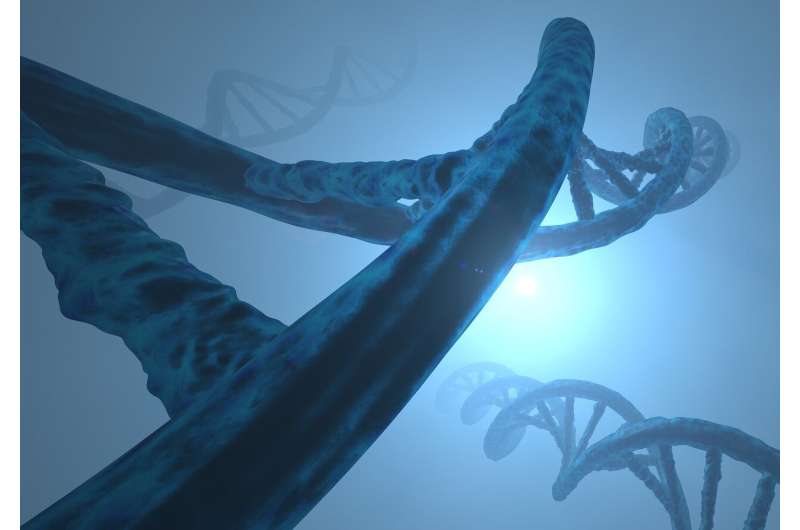Male Y chromosome facilitates the evolution of sex differences in body size

Females and males differ in many ways and yet they share the same genome. The only exception is the male Y chromosome. Using beetles as a study system, new research from Uppsala University, now published in Nature Ecology & Evolution, shows that despite the Y chromosome containing very few genes, it can dramatically change male body size and thus facilitate the evolution of sex differences.
Females and males typically differ in many ways in their morphology, physiology and behavior. How such sex differences, known as sexual dimorphism, evolve is a puzzle because females and males share the same set of genes and an evolutionary change in one sex should cause a correlated change even in the other sex, thereby preventing sex differences from evolving. The new study shows that even small amounts of genetic differences between the sexes can facilitate the evolution of sexual dimorphism such that it can evolve in just a few generations.
"Our experiments show that the autosomes as well as both sex chromosomes, the X and Y, can harbor genetic variation important for sexual dimorphism, but the Y chromosome alone can alter the sex difference in size by as much as 30 percent. This is remarkable because in these beetles the Y chromosome contains just a handful of genes and represents a very small fraction of the genome, just like in humans. Many have thought that the Y only affects the most important reproductive processes in males, namely sperm production. Our findings suggest that the Y chromosome may have a broader role than previously appreciated," says Philipp Kaufmann, a Ph.D. student at the Uppsala University's Department of Ecology and Genetics and the first author of the study.
The evolution of sexual dimorphism is however not only dependent on where in the genome genetic variation resides, but also on how natural and sexual selection can act on it. With the help of lab evolution, the research team showed that sexual size dimorphism could evolve when selecting on male size, but that when selection acted only on females, the shared part of the genome caused a correlated evolutionary response in males preventing dimorphism from evolving.
"The most drastic change in sexual dimorphism, an increase by 50 percent in only ten generations, occurred when we applied selection sexually antagonistically—favoring the opposite body size in the two sexes. This shows that under right kind of selection sex differences can clearly evolve rapidly, perhaps more easily than was previously thought," says Elina Immonen, Assistant Professor at the Department of Ecology and Genetics, Uppsala University, and the principle investigator of the study.
"Combining information of what kind of genetic variation is available to selection with different forms of selection is a powerful way to test the determinants of evolution of sex differences. By isolating the effect of Y chromosome variation from the rest of the genome, we could directly demonstrate how large the effect of the Y chromosome is, something we didn't expect to see when we started the work and this has helped understand how sexual dimorphism has evolved in this species. Future work will tell us more regarding how the Y chromosome can have such a large effect on males and how general its role is in the evolution of sex differences across taxa," Immonen concludes.
More about the experiments
In their study, the researchers characterized the genetic architecture of body size in males and females by creating a large pedigree of over 8,000 beetles (the seed beetle Callosobruchus maculatus). This multi-generational family tree was used to quantify autosomal and sex chromosome linked genetic variation in body size. The use of artificial selection allowed testing how different forms of selection affect the evolution of size dimorphism and included selection acting only on males, only on females, or acting sexually antagonistically (in the opposite directions) in the two sexes. After ten generations of selection, the sexual size dimorphism was compared between the selection lines and the ancestral pedigree population. These two experiments clearly indicated that the Y chromosome play an important role in determining male response to selection. In order to test further the effect of the Y linked variation in isolation from variation in the rest of the genome, the research team carried out a third experiment. They isolated the effect of the Y chromosome on sexual size dimorphism in these beetles by introducing the different Y chromosomes into a genetically identical background. In other words, creating beetles that are identical twins to each other except for the Y chromosome.
More information: Philipp Kaufmann et al, Rapid evolution of sexual size dimorphism facilitated by Y-linked genetic variance, Nature Ecology & Evolution (2021). DOI: 10.1038/s41559-021-01530-z
Journal information: Nature Ecology & Evolution
Provided by Uppsala University





















